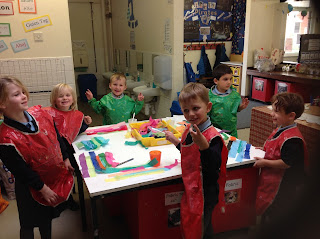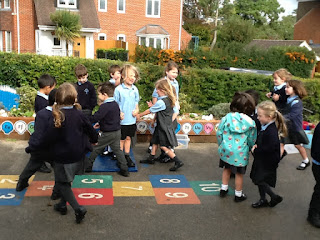- Requests and reminders:
- Don't forget 'Witches and Wizards day' is on Monday 12th October. Please can your child come dressed as a witch or wizard.
- Consultations are next Wednesday 14th October and Monday 19th October. You should have made your appointment online. Two parents are allowed to attend but in order to keep everyone safe please arrive on time for your appointment and not too early! Please wear a mask.
- Please could you make sure your child brings in a coat to school as it is getting colder. As you can imagine in this current time we have to have all the doors and windows open so even indoors is cold! Vests or thermals would also be a good idea!
- We are in need of conkers and pine cones for our woodland learning activities. We would be very grateful for any you find. I'm sure the children would love a walk to hunt for some this weekend!
- Please can you remember to return the Tapestry permission slips so we can get this set up as soon as possible.
- Spare school uniform. If you have any girls or boys socks we can have for spare, we would be very grateful. We seem to have quite a few children getting muddy at the moment!
- Things to do...
- Just a reminder to please cover your child's home school book or place it in a small plastic wallet. Please also make sure it is in your child's book bag everyday.
- Your child has the opportunity to change their reading books during 5 minute warning. We will remind them everyday. If they are not changing their book, please send them back into school to change it if necessary.
- As your child is now bringing a reading book home please can you return the other books you have borrowed from school.
- Read to your child every day. Talk about rhyming words.
- Play maths games with dice.
- Count everything. For example: ask them to lay the table with 4 forks, 4 knives etc, point out numbers and shapes in the environment.
- Recap the phonics activities your child completed this week. See below.
- Talk about the number 4.
The children have been practising their collage overlapping skills in art this week. They have been designing their Christmas cards that we are sending home today and you can decide whether you would like to place an order online for them. They can be made into Christmas cards, tags and wrapping paper to send to your friends and family. Once you have placed the order, you will need to return the design to us so that we can send them away to APFS, the company that produces them for us.
This week the children have completed a range of phonics lessons. You could have a go at playing some of these at home.
Activity 1: Alliteration
Musical
Corners. Put a chair
in each corner of the room.
Collect four
sets of objects, each set containing objects with names that start with the
same sound e.g. Pan, pen, pig and pin,
Cat, car, crib, crisps, Tin,
tiger, tap and Dog, dig and duck. (Four different initial sounds are
represented P, C T and D.)
Keep back
one object from each set and place the remaining sets on each of the four
chairs.
Name each of
the four sets of objects, giving emphasis to the initial sound.
Play some
music and when the music stops, show your child an object and they have to go
to the correct chair. Repeat with different objects.
Activity 2: Voice sounds/body percussion
Noisy
neighbour - Tell a simple story about a noisy neighbour and invite your child to
join in. Begin with: Early one morning, the children were all fast sleep – (ask
your child to close their eyes and pretend to sleep) – when all of a sudden
they heard a sound from the house next door. At this point the adult makes a
sound.
Continue the
story: Wake up. What’s that noise? Can your child identify the sound?
Together say
“Noisy neighbour, please be quiet. We
are trying to sleep”.
Repeat the
simple story line with another sound (e.g. snoring, brushing teeth, munching
cornflakes, yawning, stamping feet, washing). Encourage your child to add their
own ideas to the story about the noisy neighbour.
Activity 3: Rhythm & rhyme:
Sing the song Twinkle Twinkle Little Star emphasising the rhyming words like high and sky. Tap out the rhythm with clapping, noticing the beats in each word. Repeat with other nursery rhymes.
Activity 4: Environmental/instrumental
Turn a box
on its side with the opening facing away from the children. One by one place
between four and six familiar noisy items (e.g. a set of keys, crisp packet,
squeaky toy) into the box, pausing to name them and demonstrate the sound each
one makes.
You could
use a bag if you do not have a box.
Sing to the
tune of ‘Old MacDonald’ but using your own name or a familiar family member. Mrs Parkin has
a box ee i ee i o and in that box she has a… Stop. Gesture and ask your child
to listen. Can they guess the sound?
Activity 5: Oral blending and
segmenting
Use a soft
toy to use. The toy can only speak in sound-talk, for example just before dinner
time: Let’s tell the toy what we eat our dinner with. Agree that we use a fork.
Then tell the toy in sound-talk which the children repeat. (f-or-k) Continue with: Let’s tell the toy what we
drink out of. Agree on ‘cup’. So you would say this is a c-u-p cup. Repeat in sound-talk for the toy to listen and
then invite your child to do the same. Think of other scenarios which they
could tell the toy or let them give him instructions. Then model the sound-talk
for your child to repeat. This is teaching the children to segment words into
their separate sounds or phonemes and is the reverse of blending. Your child
will soon begin to start the segmenting themselves.
Some words
you could use are:
c-u-p cup
f-o-r-k fork
p-ea-s peas
h-a-m ham
r-o-ll roll
ch-ee-se cheese
In maths we have been learning about the number 4.
We introduced the number 4 and counted to four. We counted 4 objects.
We showed the children the number 4 Numicon piece. We drew a square and a rectangle on a piece of paper and explained that they
have 4 sides and 4 corners. We looked at the pattern of 4 dots on a dice.
The children completed two activities. In the first session the children were using the Numicon to make 4 in different ways. We discussed that there are different ways to make 4. They explored this using 1,2,3 and 4 Numicon pieces. They were then encouraged to verbalise it too. 3 and 1 makes 4.
In the second activity the children used counters.
They took 4 counters (we practised accurate counting). They placed them on the first frame which has 4 sections. We discussed the different ways that children have placed them. We asked them to take another 4 counters and make a different pattern and asked the children to verbalise how they have placed them e.g. I have 1 yellow and 3 red. They repeated this several times and we modelled how we could record these as number sentences on the board.



















































